Question Number 16483 by RasheedSoomro last updated on 23/Jun/17
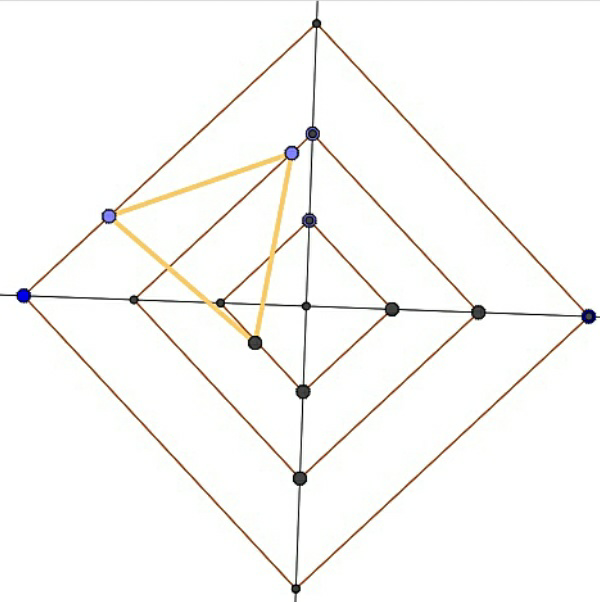
Commented by RasheedSoomro last updated on 23/Jun/17

$$\mathrm{Thanks}\:\mathrm{sir}\:\mathrm{for}\:\mathrm{mentioning}\:\mathrm{mistake}. \\ $$$$\mathrm{The}\:\mathrm{figure}\:\mathrm{has}\:\mathrm{been}\:\mathrm{changed}. \\ $$
Commented by RasheedSoomro last updated on 23/Jun/17
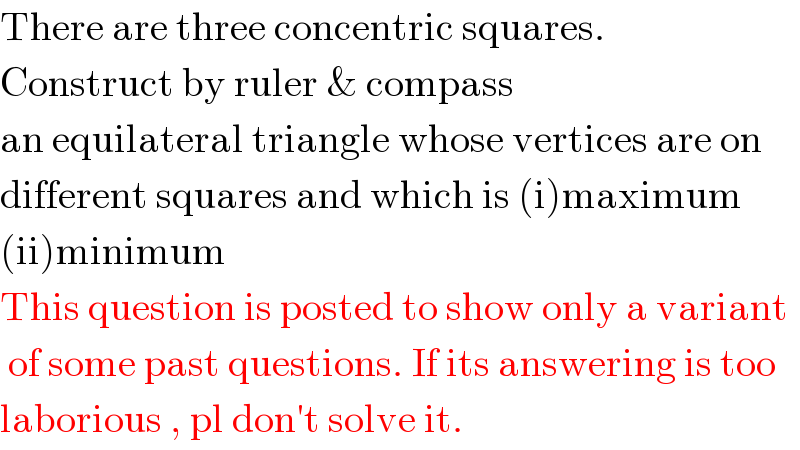
$$\mathrm{There}\:\mathrm{are}\:\mathrm{three}\:\mathrm{concentric}\:\mathrm{squares}. \\ $$$$\mathrm{Construct}\:\mathrm{by}\:\mathrm{ruler}\:\&\:\mathrm{compass}\: \\ $$$$\mathrm{an}\:\mathrm{equilateral}\:\mathrm{triangle}\:\mathrm{whose}\:\mathrm{vertices}\:\mathrm{are}\:\mathrm{on} \\ $$$$\mathrm{different}\:\mathrm{squares}\:\mathrm{and}\:\mathrm{which}\:\mathrm{is}\:\left(\mathrm{i}\right)\mathrm{maximum} \\ $$$$\left(\mathrm{ii}\right)\mathrm{minimum} \\ $$$$\mathrm{This}\:\mathrm{question}\:\mathrm{is}\:\mathrm{posted}\:\mathrm{to}\:\mathrm{show}\:\mathrm{only}\:\mathrm{a}\:\mathrm{variant} \\ $$$$\:\mathrm{of}\:\mathrm{some}\:\mathrm{past}\:\mathrm{questions}.\:\mathrm{If}\:\mathrm{its}\:\mathrm{answering}\:\mathrm{is}\:\mathrm{too} \\ $$$$\mathrm{laborious}\:,\:\mathrm{pl}\:\mathrm{don}'\mathrm{t}\:\mathrm{solve}\:\mathrm{it}. \\ $$
Commented by mrW1 last updated on 23/Jun/17
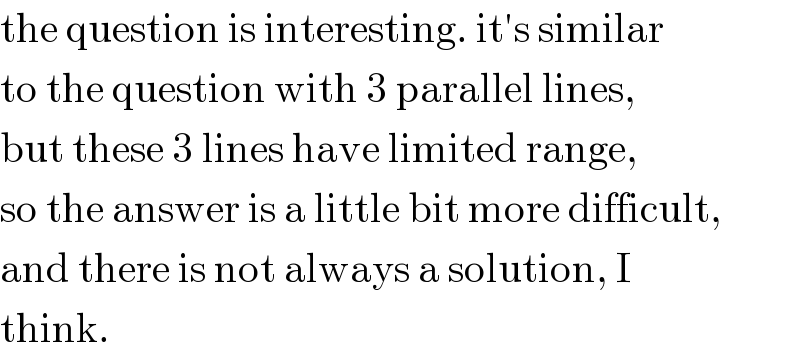
$$\mathrm{the}\:\mathrm{question}\:\mathrm{is}\:\mathrm{interesting}.\:\mathrm{it}'\mathrm{s}\:\mathrm{similar} \\ $$$$\mathrm{to}\:\mathrm{the}\:\mathrm{question}\:\mathrm{with}\:\mathrm{3}\:\mathrm{parallel}\:\mathrm{lines}, \\ $$$$\mathrm{but}\:\mathrm{these}\:\mathrm{3}\:\mathrm{lines}\:\mathrm{have}\:\mathrm{limited}\:\mathrm{range}, \\ $$$$\mathrm{so}\:\mathrm{the}\:\mathrm{answer}\:\mathrm{is}\:\mathrm{a}\:\mathrm{little}\:\mathrm{bit}\:\mathrm{more}\:\mathrm{difficult}, \\ $$$$\mathrm{and}\:\mathrm{there}\:\mathrm{is}\:\mathrm{not}\:\mathrm{always}\:\mathrm{a}\:\mathrm{solution},\:\mathrm{I} \\ $$$$\mathrm{think}. \\ $$
Commented by RasheedSoomro last updated on 23/Jun/17
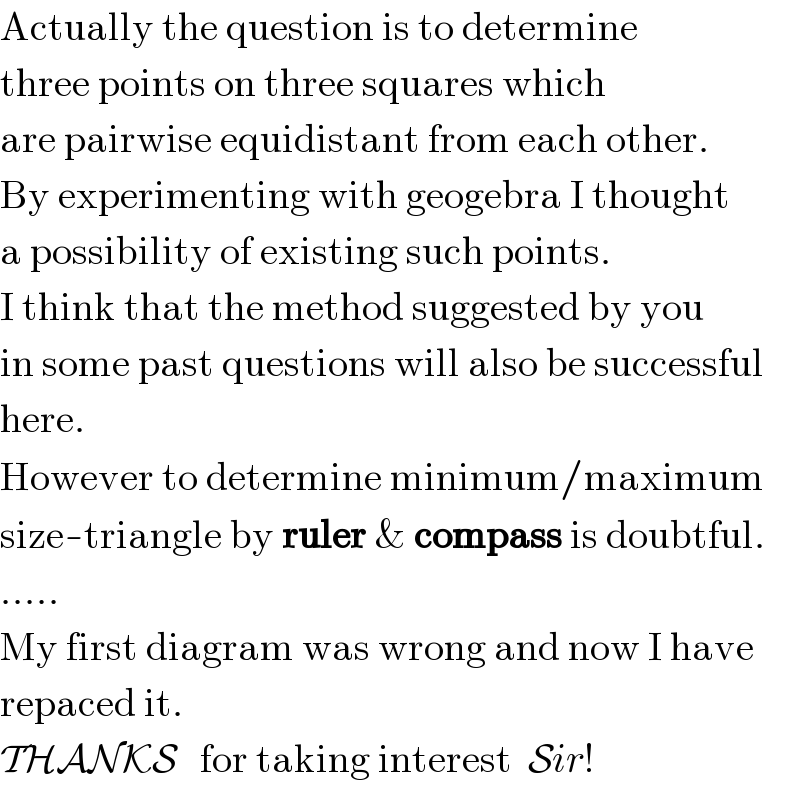
$$\mathrm{Actually}\:\mathrm{the}\:\mathrm{question}\:\mathrm{is}\:\mathrm{to}\:\mathrm{determine} \\ $$$$\mathrm{three}\:\mathrm{points}\:\mathrm{on}\:\mathrm{three}\:\mathrm{squares}\:\mathrm{which} \\ $$$$\mathrm{are}\:\mathrm{pairwise}\:\mathrm{equidistant}\:\mathrm{from}\:\mathrm{each}\:\mathrm{other}. \\ $$$$\mathrm{By}\:\mathrm{experimenting}\:\mathrm{with}\:\mathrm{geogebra}\:\mathrm{I}\:\mathrm{thought} \\ $$$$\mathrm{a}\:\mathrm{possibility}\:\mathrm{of}\:\mathrm{existing}\:\mathrm{such}\:\mathrm{points}. \\ $$$$\mathrm{I}\:\mathrm{think}\:\mathrm{that}\:\mathrm{the}\:\mathrm{method}\:\mathrm{suggested}\:\mathrm{by}\:\mathrm{you} \\ $$$$\mathrm{in}\:\mathrm{some}\:\mathrm{past}\:\mathrm{questions}\:\mathrm{will}\:\mathrm{also}\:\mathrm{be}\:\mathrm{successful} \\ $$$$\mathrm{here}. \\ $$$$\mathrm{However}\:\mathrm{to}\:\mathrm{determine}\:\mathrm{minimum}/\mathrm{maximum} \\ $$$$\mathrm{size}-\mathrm{triangle}\:\mathrm{by}\:\boldsymbol{\mathrm{ruler}}\:\&\:\boldsymbol{\mathrm{compass}}\:\mathrm{is}\:\mathrm{doubtful}. \\ $$$$….. \\ $$$$\mathrm{My}\:\mathrm{first}\:\mathrm{diagram}\:\mathrm{was}\:\mathrm{wrong}\:\mathrm{and}\:\mathrm{now}\:\mathrm{I}\:\mathrm{have} \\ $$$$\mathrm{repaced}\:\mathrm{it}. \\ $$$$\mathcal{THANKS}\:\:\:\mathrm{for}\:\mathrm{taking}\:\mathrm{interest}\:\:\mathcal{S}{ir}! \\ $$
Commented by mrW1 last updated on 23/Jun/17
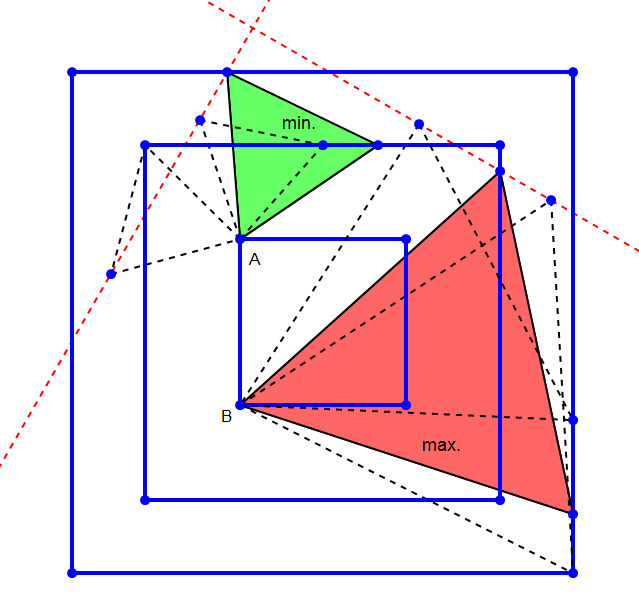
Commented by RasheedSoomro last updated on 23/Jun/17
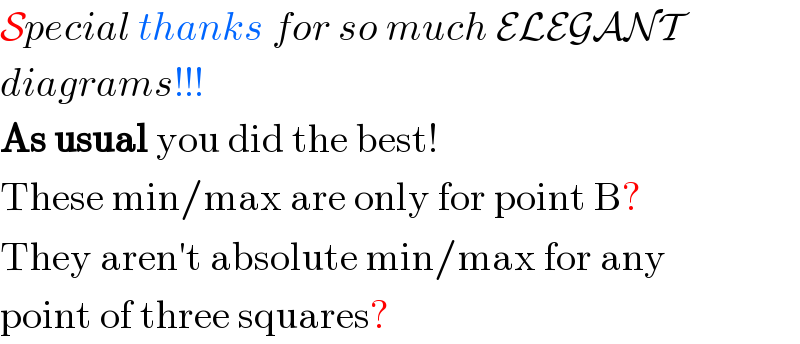
$$\mathcal{S}{pecial}\:{thanks}\:{for}\:{so}\:{much}\:\mathcal{ELEGANT}\:\: \\ $$$${diagrams}!!! \\ $$$$\boldsymbol{\mathrm{As}}\:\boldsymbol{\mathrm{usual}}\:\mathrm{you}\:\mathrm{did}\:\mathrm{the}\:\mathrm{best}! \\ $$$$\mathrm{These}\:\mathrm{min}/\mathrm{max}\:\mathrm{are}\:\mathrm{only}\:\mathrm{for}\:\mathrm{point}\:\mathrm{B}? \\ $$$$\mathrm{They}\:\mathrm{aren}'\mathrm{t}\:\mathrm{absolute}\:\mathrm{min}/\mathrm{max}\:\mathrm{for}\:\mathrm{any} \\ $$$$\mathrm{point}\:\mathrm{of}\:\mathrm{three}\:\mathrm{squares}? \\ $$
Commented by mrW1 last updated on 23/Jun/17
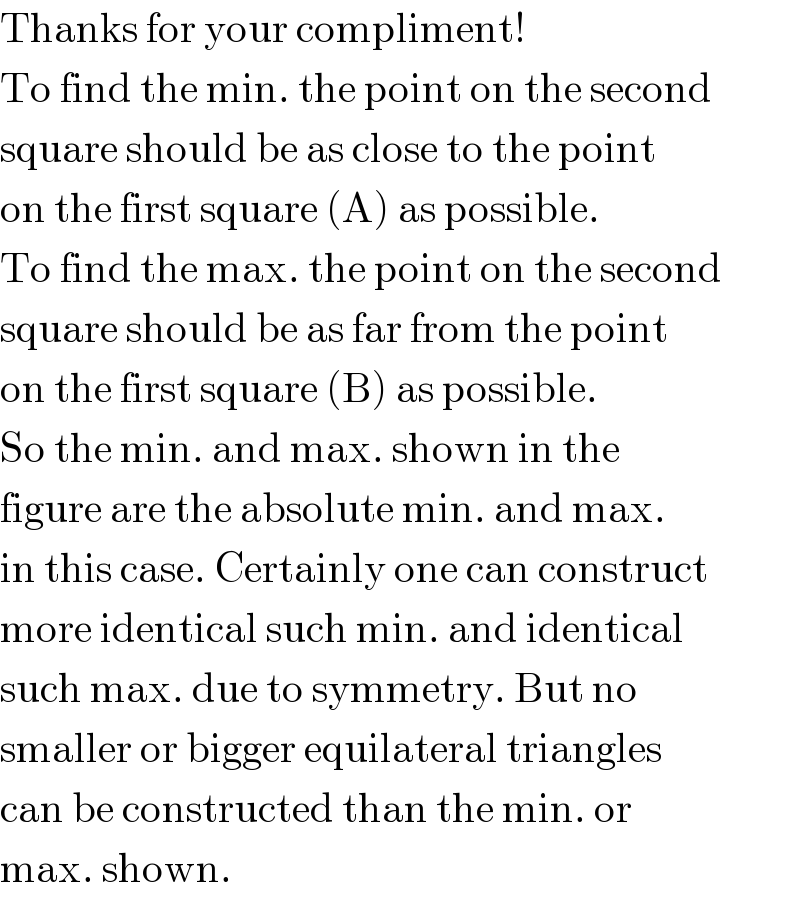
$$\mathrm{Thanks}\:\mathrm{for}\:\mathrm{your}\:\mathrm{compliment}! \\ $$$$\mathrm{To}\:\mathrm{find}\:\mathrm{the}\:\mathrm{min}.\:\mathrm{the}\:\mathrm{point}\:\mathrm{on}\:\mathrm{the}\:\mathrm{second} \\ $$$$\mathrm{square}\:\mathrm{should}\:\mathrm{be}\:\mathrm{as}\:\mathrm{close}\:\mathrm{to}\:\mathrm{the}\:\mathrm{point} \\ $$$$\mathrm{on}\:\mathrm{the}\:\mathrm{first}\:\mathrm{square}\:\left(\mathrm{A}\right)\:\mathrm{as}\:\mathrm{possible}. \\ $$$$\mathrm{To}\:\mathrm{find}\:\mathrm{the}\:\mathrm{max}.\:\mathrm{the}\:\mathrm{point}\:\mathrm{on}\:\mathrm{the}\:\mathrm{second} \\ $$$$\mathrm{square}\:\mathrm{should}\:\mathrm{be}\:\mathrm{as}\:\mathrm{far}\:\mathrm{from}\:\mathrm{the}\:\mathrm{point} \\ $$$$\mathrm{on}\:\mathrm{the}\:\mathrm{first}\:\mathrm{square}\:\left(\mathrm{B}\right)\:\mathrm{as}\:\mathrm{possible}. \\ $$$$\mathrm{So}\:\mathrm{the}\:\mathrm{min}.\:\mathrm{and}\:\mathrm{max}.\:\mathrm{shown}\:\mathrm{in}\:\mathrm{the} \\ $$$$\mathrm{figure}\:\mathrm{are}\:\mathrm{the}\:\mathrm{absolute}\:\mathrm{min}.\:\mathrm{and}\:\mathrm{max}. \\ $$$$\mathrm{in}\:\mathrm{this}\:\mathrm{case}.\:\mathrm{Certainly}\:\mathrm{one}\:\mathrm{can}\:\mathrm{construct} \\ $$$$\mathrm{more}\:\mathrm{identical}\:\mathrm{such}\:\mathrm{min}.\:\mathrm{and}\:\mathrm{identical} \\ $$$$\mathrm{such}\:\mathrm{max}.\:\mathrm{due}\:\mathrm{to}\:\mathrm{symmetry}.\:\mathrm{But}\:\mathrm{no} \\ $$$$\mathrm{smaller}\:\mathrm{or}\:\mathrm{bigger}\:\mathrm{equilateral}\:\mathrm{triangles} \\ $$$$\mathrm{can}\:\mathrm{be}\:\mathrm{constructed}\:\mathrm{than}\:\mathrm{the}\:\mathrm{min}.\:\mathrm{or} \\ $$$$\mathrm{max}.\:\mathrm{shown}. \\ $$
Commented by RasheedSoomro last updated on 23/Jun/17

$$\mathcal{S}{ir},\:{c}\mathrm{an}\:\mathrm{it}\:\mathrm{be}\:\mathrm{possible}\:\mathrm{to}\:\mathrm{draw}\:\mathrm{these}\:\mathrm{min} \\ $$$$\mathrm{or}\:\mathrm{max}\:\mathrm{by}\:\mathrm{ruler}\:\&\:\mathrm{compass}? \\ $$
Commented by mrW1 last updated on 23/Jun/17

$$\mathrm{Yes}.\:\mathrm{The}\:\mathrm{method}\:\mathrm{I}\:\mathrm{showed}\:\mathrm{uses}\:\mathrm{only} \\ $$$$\mathrm{ruler}\:\mathrm{and}\:\mathrm{compass}\:\mathrm{in}\:\mathrm{mathematical} \\ $$$$\mathrm{sense}\:\mathrm{though}\:\mathrm{I}\:\mathrm{work}\:\mathrm{on}\:\mathrm{computer}. \\ $$
Commented by mrW1 last updated on 23/Jun/17
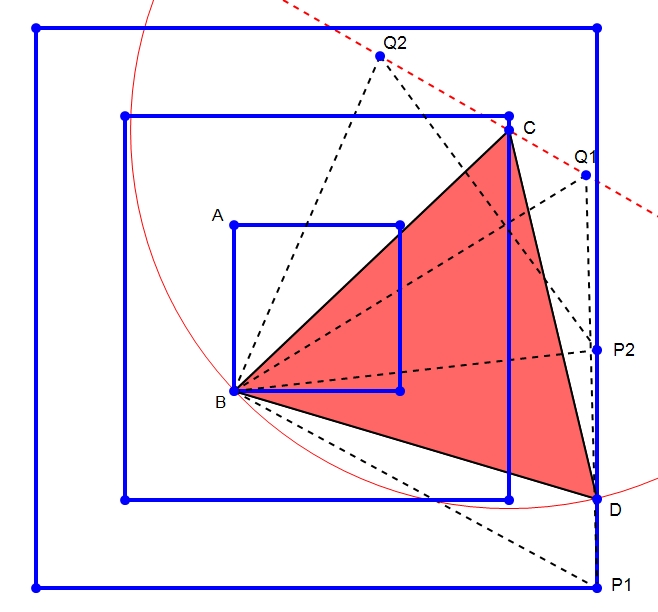
Commented by mrW1 last updated on 24/Jun/17
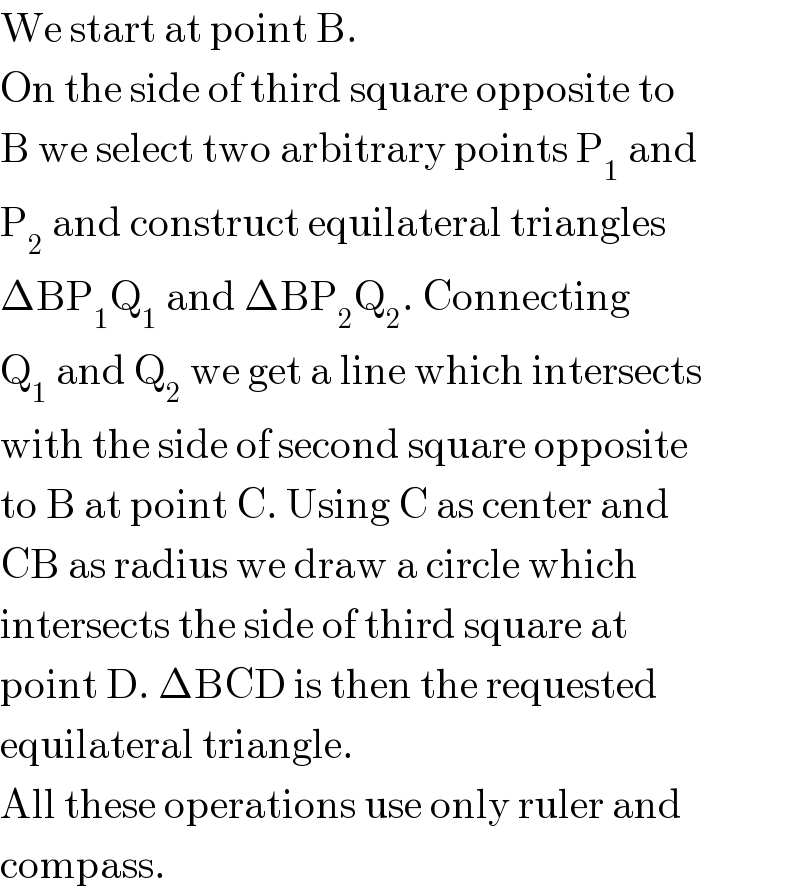
$$\mathrm{We}\:\mathrm{start}\:\mathrm{at}\:\mathrm{point}\:\mathrm{B}. \\ $$$$\mathrm{On}\:\mathrm{the}\:\mathrm{side}\:\mathrm{of}\:\mathrm{third}\:\mathrm{square}\:\mathrm{opposite}\:\mathrm{to}\: \\ $$$$\mathrm{B}\:\mathrm{we}\:\mathrm{select}\:\mathrm{two}\:\mathrm{arbitrary}\:\mathrm{points}\:\mathrm{P}_{\mathrm{1}} \:\mathrm{and}\: \\ $$$$\mathrm{P}_{\mathrm{2}} \:\mathrm{and}\:\mathrm{construct}\:\mathrm{equilateral}\:\mathrm{triangles} \\ $$$$\Delta\mathrm{BP}_{\mathrm{1}} \mathrm{Q}_{\mathrm{1}} \:\mathrm{and}\:\Delta\mathrm{BP}_{\mathrm{2}} \mathrm{Q}_{\mathrm{2}} .\:\mathrm{Connecting} \\ $$$$\mathrm{Q}_{\mathrm{1}} \:\mathrm{and}\:\mathrm{Q}_{\mathrm{2}} \:\mathrm{we}\:\mathrm{get}\:\mathrm{a}\:\mathrm{line}\:\mathrm{which}\:\mathrm{intersects} \\ $$$$\mathrm{with}\:\mathrm{the}\:\mathrm{side}\:\mathrm{of}\:\mathrm{second}\:\mathrm{square}\:\mathrm{opposite} \\ $$$$\mathrm{to}\:\mathrm{B}\:\mathrm{at}\:\mathrm{point}\:\mathrm{C}.\:\mathrm{Using}\:\mathrm{C}\:\mathrm{as}\:\mathrm{center}\:\mathrm{and} \\ $$$$\mathrm{CB}\:\mathrm{as}\:\mathrm{radius}\:\mathrm{we}\:\mathrm{draw}\:\mathrm{a}\:\mathrm{circle}\:\mathrm{which} \\ $$$$\mathrm{intersects}\:\mathrm{the}\:\mathrm{side}\:\mathrm{of}\:\mathrm{third}\:\mathrm{square}\:\mathrm{at} \\ $$$$\mathrm{point}\:\mathrm{D}.\:\Delta\mathrm{BCD}\:\mathrm{is}\:\mathrm{then}\:\mathrm{the}\:\mathrm{requested}\: \\ $$$$\mathrm{equilateral}\:\mathrm{triangle}. \\ $$$$\mathrm{All}\:\mathrm{these}\:\mathrm{operations}\:\mathrm{use}\:\mathrm{only}\:\mathrm{ruler}\:\mathrm{and} \\ $$$$\mathrm{compass}. \\ $$
Commented by RasheedSoomro last updated on 24/Jun/17
![[(T,H,A,N,K,S),(H,⌈,�,�,⌉,K),(A,∣,⌈,⌉,∣,N),(N,∣,⌊,⌋,∣,A),(K,⌊,_,_,⌋,H),(S,K,N,A,H,T) ]! Appriciate your knowledge of geometry! Appriciate your knowledge-sharing skill! Appriciate your sharing-sprit!](https://www.tinkutara.com/question/Q16584.png)
$$\begin{bmatrix}{\mathcal{T}}&{\mathcal{H}}&{\mathcal{A}}&{\mathcal{N}}&{\mathcal{K}}&{\mathcal{S}}\\{\mathcal{H}}&{\lceil}&{�}&{�}&{\rceil}&{\mathcal{K}}\\{\mathcal{A}}&{\mid}&{\lceil}&{\rceil}&{\mid}&{\mathcal{N}}\\{\mathcal{N}}&{\mid}&{\lfloor}&{\rfloor}&{\mid}&{\mathcal{A}}\\{\mathcal{K}}&{\lfloor}&{\_}&{\_}&{\rfloor}&{\mathcal{H}}\\{\mathcal{S}}&{\mathcal{K}}&{\mathcal{N}}&{\mathcal{A}}&{\mathcal{H}}&{\mathcal{T}}\end{bmatrix}! \\ $$$$\mathrm{Appriciate}\:\mathrm{your}\:\mathrm{knowledge}\:\mathrm{of}\:\mathrm{geometry}! \\ $$$$\mathrm{Appriciate}\:\mathrm{your}\:\mathrm{knowledge}-\mathrm{sharing}\:\mathrm{skill}! \\ $$$$\mathrm{Appriciate}\:\mathrm{your}\:\mathrm{sharing}-\mathrm{sprit}! \\ $$$$ \\ $$
